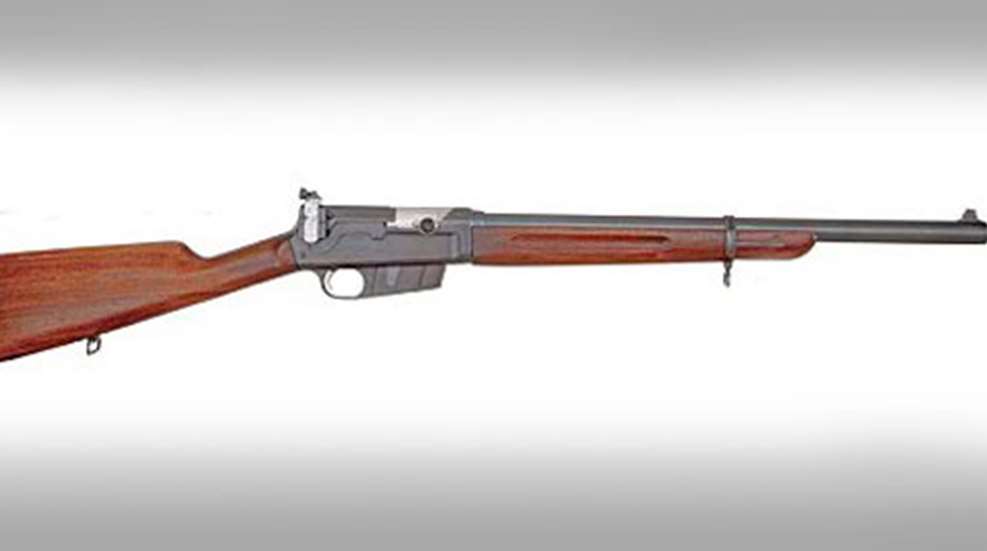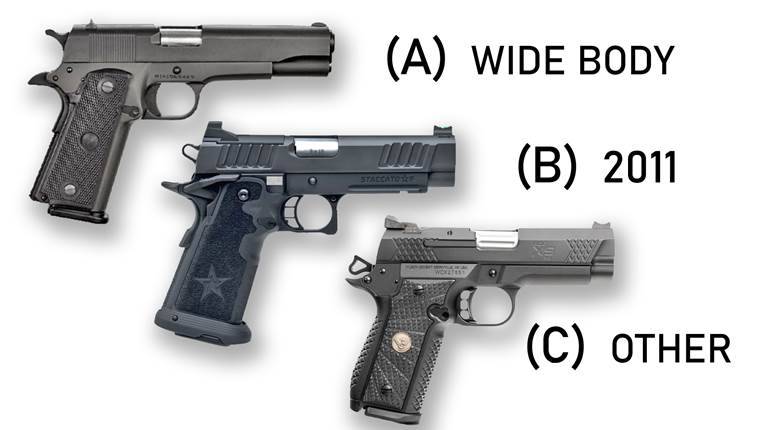
Remington was not the first American manufacturer to introduce a center-fire semi-automatic rifle. Truth be told, Winchester’s Model 1905 came first, but its potential was limited by its direct blowback action. The gun’s hollow fore-end contained an inertia block, an admittedly creative solution that kept the receiver compact and streamlined, but made the gun unbalanced. The .32 Winchester Self Loading and the .35 Winchester Self Loading cartridges for which it was chambered were an even greater handicap. They lacked the power to reliably anchor medium-size game and, even for small game, they were of limited value. These limitations kept the Winchester Model 1905 from catching on as anything more than an expensive novelty. In contrast, the gun that became the Remington Model 8 was a fully realized semi-automatic rifle capable of reliably cycling powerful center-fire cartridges. Originally introduced as the Remington Autoloading Rifle in 1906, the name was changed to the Remington Model 8 in 1911, even though the rifle itself was essentially unchanged.
Designed by John Moses Browning while he was working on his first semi-automatic shotgun, the Browning Auto-5, the new rifle used the same long-stroke recoil operating system as his new shotgun. The gun’s lightweight barrel and its buffer and recoil springs reciprocate within a large diameter barrel jacket made of thin-walled steel. The twin-lugged bolt locks into a barrel extension. A five-round fixed box magazine that could be filled by means of five-round stripper clips fed the action. Additionally, four unique chamberings—.25 Rem., .30 Rem, .32 Rem. and .35 Rem.—were developed for the Remington Model 8.
It was the first mass-produced semi-automatic rifle chambered for a round more powerful than the most popular deer cartridge of its day, the .30-30 Win. Remington was not shy about using the unique power of its semi-automatic rifle as a selling point. Remington ads from 1907 touted the ability of a Remington Autoloading Rifle in .35 Rem. to pierce a 5/16" steel plate. Promotional artwork portrayed outdoorsmen face to face with bear, wolves and other dangerous animals. Remington’s message was clear, the Model 8 is a gun you can rely on in close-quarters life or death situations.
Winchester countered with the Model 1907 and Model 1910, which were chambered in .351 Winchester Self Loading and .401 Winchester Self Loading, respectively. A heavier inertia block compensated for their increased energy, but the extra weight in the fore-end was not sufficient to tame the recoil of the more powerful chamberings and made the guns even more muzzle-heavy than the Model 1905. Even though Winchester ads trumpeted the Model 1910 as “the gun that shoots through steel,” it was not as powerful as the .35 Rem. What the ads didn’t say was that the steel the 1910 shot through was 1/4" steel plate rather than 5/16" of the Remington.
The Model 8’s popularity with hunters was restricted by the limitations of its design. Its long-stroke system of recoil operation and slim-wristed buttstock seemed to attenuate perceived recoil, and its poor center of balance, while nowhere near as bad as the Winchester semi-automatics, made for awkward carry and handling. Additionally, the economic deprivation of the Great Depression further eroded already weak sales.
During the 1930s, both large and small manufacturers were forced to cease production of a number of interesting, unique and desirable firearms. Several firearm manufacturers went under as well, but DuPont’s purchase of Remington in 1934 provided re-energized leadership and an infusion of capital and that kept Remington afloat through those hard times. The Model 8 survived thanks to a timely redesign that streamlined production and lowered costs. Remington also added a thicker wrist and fore-end to better absorb the gun’s stout recoil.
The new gun, dubbed the Model 81, debuted in 1936. But if the Great Depression’s hardships limited the gun’s commercial success with hunters, they also spawned a crime wave that earned the powerful Remington semi-automatics a small but enthusiastic group of followers: America’s law enforcement officers.
At the time, the rural Midwest was set upon by bands of highway bank robbers like Bonnie Parker and Clyde Barrow who relied on fast, heavy cars and firepower for escape. Their cars were usually Fords whose heavy doors stopped most handgun bullets, and their firearms of choice were sawed-off Browning Auto-5 shotguns or M1918 BARs stolen from National Guard Armories.
Faced with this threat, lawmen like Texas Ranger Frank Hamer turned to the Remington Model 8. Hamer chose a Remington Model 8 in .30 Rem., but later switched to .35 Rem for more power. Wielding a Remington Model 8 fitted with an extended 20-round magazine purchased from the Peace Officers Equipment Company in St. Josephs, Mo., Hamer led the “Posse of Six” that ultimately ambushed and killed Bonnie and Clyde just outside Gibsland, La., in 1934. Recognizing Law Enforcement’s affection for its semi-automatic rifle, Remington released a “Special Police” variant. The Remington Model 81 Special Police was fitted with sling swivels and an extended 15-round magazine.
Military interest was limited. During the First World War, Gen. Pershing requested Remington Model 8s and armor-piercing .35 Rem. ammunition. It is believed these rifles were intended as stop-gap issue to aircrewmen, but it is not known what, if anything, came of this request. In 1922 the Infantry Board bought 25 Model 8s chambered in .25 Rem. The Army wanted to see how a semi-automatic rifle would affect marksmanship training, combat doctrine and logistics. The Remington Model 81 sold almost twice as fast as its parent, but sales were still modest by any standard. Despite its mediocre sales figures, the Remington Model 81 was cataloged up until 1950. Recognizing that there was nothing more that could be done with the Model 81, Remington started work on a new semi-automatic center-fire rifle in 1940, hence the origin of its name, the Model 740.
The new rifle was developed concurrently with Remington’s pump-action 760. Development work was assigned to two competing design teams, the first was led by L.R. Crittenden and the second by Bill Gail, Jr. One of the main performance criteria for the 740 was that it would have to be compatible with popular .30-’06 Sprg. loads. The path to the peak of that mountain is steeper and longer than it looks. The scale of the task made the 740’s development slow and the production demands of the Second World War forced Remington to suspend critical design work in its early stages. In the end, Remington did not release the Model 740 until 1955.
The Remington Model 8 and other early semi-automatic rifles used ammunition that was designed to work within the limitations of the gun. The 740, on the other hand, would have to work with a variety of commercial loads. This would make the 740 even tougher to design than a military semi-automatic.
A military rifle needs to work with just a handful of loads, ball, tracer and AP, but the 740 would have to shoot a variety of loads that produce different energy levels, use different bullet ogives and cartridge overall lengths. It would have to cycle them all reliably and deliver reasonable accuracy. No mean feat.
In many ways the Remington 740 was everything the Remington 8 wasn’t. First, it looked like a shotgun, so it was attractive. Second, being well balanced it handled like a shotgun. Third, its short-stroke gas operation mitigated recoil. Remington ads touted the 740’s semi-automatic action as “power-matic like a jet.” Fourth, it was chambered for popular hunting cartridges such as the .30-’06 Sprg.
Gen. Julian Hatcher and Elmer Keith reviewed the 740 in the February 1955 edition of The American Rifleman. They praised the 740’s excellent handling and sound ergonomics, especially the four-round detachable magazine that held the bolt open after the last shot. Keith considered the gun reasonably accurate and an ideal choice for fast-moving game. It was certainly more accurate than most other semi-automatic, lever-action or slide-action sporters, if not as accurate as most bolt-action rifles. Gen. Hatcher praised the 740’s inherent safety, particularly the tight lockup provided by the interrupted locking lugs on the rotary bolt. However, he did note some problems with disassembly. The gas system was so sensitive and complex that Remington warned users against disassembling it themselves. If cleaning with rags, brushes and sprays couldn’t restore functioning, users were told to take it to a gunsmith for disassembly. In his review, Gen. Hatcher agreed with this assessment.
More troubling was Hatcher’s discovery that removing the fore-end to clean the gas system had the potential to alter the gun’s zero, and that improper tightening of the fore-end retaining screw during reassembly could degrade accuracy. Worse yet, there was no way to tell by look or feel if something was wrong. So the user wouldn’t know there was a problem until he took it to the range. Even with these idiosyncrasies, the Remington 740 was the best center-fire, semi-automatic sporting rifle available at the time. Compact, sleek and light, it was just the ticket for hunting fast-moving game in thick brush.
Remington addressed many of the 740’s problems with the release of the 742 in 1960. The basic design was unchanged, but a close look inside the gun revealed a number of improvements. The barrel of the 740 was fixed with a capstan breech ring nut that required the aid of a special spanner. The barrel of the 742, on the other hand, used a simple hex nut that could be turned out with a common open-end wrench. Needless to say this greatly eased disassembly. In order to help the user consistently tighten the fore-end for consistent accuracy, the fore-end screw of the 742 was cut with two sets of threads, each with a different pitch. The fine-pitch rear threads interface with the barrel lug, while the coarser threads move the fore-end nut back more slowly. This allows the fore-end to catch up with the nut and seat tightly against it as the fore-end screw is tightened. Consistent tightening of the fore-end keeps it from putting any tension on the barrel that would adversely affect accuracy. Changes to the bolt cam improved reliability, it was altered to smooth the bolt’s transition from rotary to lateral motion. Smoother motion delivered more consistent bolt velocity throughout its travel and reduced its tendency to bind.
The 742 remained relatively unchanged until Remington released the Model 7400 and the Model Four in 1981. Functionally, the guns were identical. The 7400 and the Model Four differed only in fit and finish. These new rifles contained a number of mechanical improvements over the 742 that focused on improving reliability. In particular, the interrupted thread locking lugs of the 742 were discarded. The bolt of the 7400 and Model Four had just four locking lugs.
This simplification allowed Remington to tighten dimensional tolerances for better contact between the locking lugs and their seats in the barrel extension.
Reliability improvements included changes to the magazine. The shape of follower and the angle of the feed lips were altered so cartridges were fed at a shallower angle. This kept the nose of the bullet from hanging up on the hood of the barrel extension. Additionally, the throat of the breech was opened up to help guide the cartridges into the chamber mouth. The 742’s riveted extractor was dropped in favor of a new variant retained in an annular groove, similar to the one used on Remington’s Model 700 bolt-action rifle.
The new Model 750 is the fourth generation of the original Model 740. Unfortunately, I had never had much of a chance to handle Remington semi-automatic rifles before, so when it pulled it out of the box, I was pleasantly surprised by the gun’s streamlined contours and trim 71/2-lb. weight. Remington 740s have been offered with a wide variety of fore-ends, but the one on the new 750 is the handiest and most attractive I’ve seen. What I like most of all are the sharply recessed flutes that run along its entire length. The flutes really helped my support hand get a firm and repeatable grip. The free-rotating sling swivel stud on the tip of the fore-end is a feature not found on previous models. It was a welcome find. Too many modern sporters come without any means for mounting a sling. I was glad to see that the bolt stop for the magazine was carried over from previous designs.
Beneath that fore-end is an improved gas system. Remington moved the gas block on the barrel rearward in order to capture the expanding propellant gases under greater pressure. This increases reliability by promoting more consistent bolt velocities. It also opens up the opportunity for carbine models in calibers that were not possible in the 7400. Additionally, the angle of the gas port was changed from 90 degrees to 45 degrees. Remington says that this reduces the port’s tendency to accumulate copper fouling.
I mounted a Swarovski 1.7-10X 42 mm scope on the 750, thinking that the variable magnification and wide field of view would be an asset in the dense underbrush. My confidence in the gun and the scope was justified, they both held up to the springtime rain and cold Alberta had in store for me. Hunting from a stand just outside of Hi-Level, I shot two 6-ft. bears. Both were hit just behind the shoulder, and they fell less than 20 yds. from where they were shot.
Remington autoloaders are known for good handling, power and reliability. Their sleek contours, trim lines and automatic reloading make them the perfect choice for pursuing fast game in thick cover. The Remington 740 series of rifles has been in production for just over 50 years, and over that time, Remington has continually improved its autoloading rifles. The latest in this series, the 750, is the product of 50 years of continuous improvement. It is a proud addition to Remington’s storied legacy of autoloader development.





































